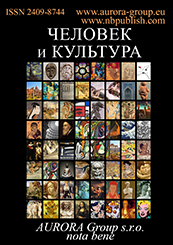Art and Art History
Reference:
Tang H.
Comparative analysis of musicality in the works of Kandinsky and Zhu Dequn
// Man and Culture.
2024. ¹ 4.
P. 1-9.
DOI: 10.25136/2409-8744.2024.4.70558 EDN: IPWIEP URL: https://en.nbpublish.com/library_read_article.php?id=70558
Abstract:
The object of the study is the works of the founder of abstract expressionism, Vasily Kandinsky, and the Chinese artist Zhu Dequn. The subject of the study is musicality in the works of Vasily Kandinsky and Zhu Dequn. The author conducts a detailed comparative analysis of abstract ideas and works of two artists in order to study their emotions and sources of inspiration. Special attention is paid to the influence of V. Kandinsky's works on Zhu Dequn's work, as a result of which the Chinese artist tried to combine Western music with the rhythms of Chinese calligraphy, giving his works a deeper meaning. In addition, from the standpoint of a sense of musicality, Zhu Dequn's works such as "The Rhythm of Rebirth" and "Pacification" are considered in the article. It is noted that Zhu Dequn's work is focused on reflecting the spirit, culture and emotions. To achieve the goal set in the research process, approaches and methods of modern philosophy, cultural studies, and art criticism were used. The main conclusions of the study are that under the influence of V. Kandinsky's theory, Zhu Dequn became more musical in his abstract paintings. Despite the fact that Zhu Dequn was not very experienced in music theory and performance, he could accurately capture the melody and rhythm of instruments such as traditional Chinese guzheng, as well as feel the light and color created by a musical composition. The author's main contribution to the study is to demonstrate the influence of V. Kandinsky on the works of Zhu Dequn, who managed to incorporate philosophical ideas and elements of local culture into his works under the influence of music, thereby creating a unique Chinese abstract art. The novelty of the study lies in the fact that the author described how Zhu Dequn's paintings reflected a combination of Chinese and Western painting, which is a valuable example for the exchange and development of Chinese and Western culture and art.
Keywords:
philosophy, emotion, creativity, musicality, painting, expressionism, abstraction, Zhu Dequn, chinese art, culture
Sociology of culture, social culture
Reference:
Shishkanov A.I.
Theoretical foundations for the development of criteria for evaluating audience preferences in modern cinema
// Man and Culture.
2024. ¹ 4.
P. 10-22.
DOI: 10.25136/2409-8744.2024.4.71062 EDN: UCPANR URL: https://en.nbpublish.com/library_read_article.php?id=71062
Abstract:
The purpose of the article is to highlight the theoretical foundations for the development of criteria for evaluating audience preferences in modern cinema. The research methodology is based on theoretical analysis, synthesis and generalization of scientific sources on the research topic, and the comparative method. The novelty of the research lies in the fact that the author highlights the theoretical foundations of the methodology of criteria and variables for assessing the success and demand of modern films as a foundation for testing and developing a questionnaire to identify audience preferences. As a conclusion, the authors states that there is a need to pay attention to the phenomena of audience choice (for example, the "certainty effect", etc.); "flow experience" within the stage of watching a movie for its emotional perception by the audience. Considering the issues of statistics, assessment of the potential commercial success of a film production and the complex of factors affecting it, it is advisable to cite D. Kahneman's position. This researcher provides an argument for the value of simple formulas for forecasting, operating with a low number of basic criteria. Thus, this author emphasizes the importance of formulas that provide equal weight for each predictive factor, which is due to their indifference to the randomness associated with the organization of the sample. In the context of the statistics of the film business sector, the corresponding hypothesis will look like this: a model for evaluating the future success of projects in certain genres is able to provide a higher level of reliability compared to models that ignore genre originality. Thus, in the study of methods for predicting the commercial success of films, carried out by A.S. Tatarnikov, the great reliability of the predictive model using information on paintings of certain genres of entertainment (in particular, adventure films, comedies, etc.) was confirmed.
Keywords:
collaborative filtering, emotional assessment of the audience, forecasting, cinema marketing, flow experience, assessing viewers' preferences, audience, film, cinema, viewer preferences
Cultural heritage, tradition and innovation
Reference:
Chuvilkina I.V.
The Church of St. Nicholas the Wonderworker in the village of Batyushkovo, Dmitrovsky district: XX century and modernity (based on the materials of museum and personal archives)
// Man and Culture.
2024. ¹ 4.
P. 23-40.
DOI: 10.25136/2409-8744.2024.4.43446 EDN: YEJVIH URL: https://en.nbpublish.com/library_read_article.php?id=43446
Abstract:
In this article, the object of research is the Church of St. Nicholas the Wonderworker in the village of Batyushkovo, Dmitrovsky district, built in the middle of the XVII century (1666). In the article, the author collects and researche information about the owners of the village and the church for three centuries, describes the events taking place with the church in the XX century. The main details and aspects of the repair and restoration of the church, which took place in 1902 and 1970, are investigated. A special section of the article is a study of the life path of the clergy of the church, the contact of their destinies with political events and repressions of the 1930s. A special contribution of the author to the study of the topic is the publication of data on the restoration of the church. Restoration documents and reports are published for the first time, architects, restorers and icon painters who participated in the restoration, painting of the church, and creating new images for believers are listed. The article contains oral memoirs of residents of the village of Batyushkovo about the existence of the church in the 1930s-1990s, published photographs from personal archives, as well as archives of the Dmitrovsky Kremlin Museum-Reserve, the A.V. Shchusev State Museum of Architecture, the State Archive of the Russian Federation, giving a voluminous idea of the history of the church and its current state.
Keywords:
nationalization of property, local history, cultural heritage, restoration, architecture, metric, Dmitrovsky district, temple, Church of St. Nicholas the Wonderworker, Batyushkovo
Art and Art History
Reference:
Azarova V.V.
Theological aspects of the libretto "St. Francis of Assisi. Franciscan Scenes" by Olivier Messiaen
// Man and Culture.
2024. ¹ 4.
P. 41-58.
DOI: 10.25136/2409-8744.2024.4.70768 EDN: YCRLZS URL: https://en.nbpublish.com/library_read_article.php?id=70768
Abstract:
In the space of the literary text of the "poem" written by the composer, the author of the article explores the features of the artistic interpretation of the fundamental religious ideas of Catholicism: the grace of the Holy Spirit, Christian revelation, mysticism, theocentrism. The elements of temple sacredness (lauda), the metamorphosis of the role of the choir, the "dancing form", as well as new forms of theatrical liturgy (prayers, responsories) are considered. Messiaen's embodiment of the principles of the mystery of the XIV–XVI centuries is considered through the prism of the composer's new understanding of the idea of synthesizing artistic elements of a musical and theatrical work. The main attention is paid to the discovery of the conceptual constants of the libretto of the Franciscan Scenes – the development of the dramaturgy of light and the compositional interaction of semantic elements. The dramatic strategy of light in Messiaen's "poem" is considered in the mirror of the works of P. Duke and K. Debussy on the text of the plays by M. Maeterlinck, as well as in the tradition of the mysteries of G. d'Annuzio, K. Debussy and P. Claudel. The hermeneutical reconstruction of the author's idea makes it possible to identify the dominant meaning of the theological constants in Messiaen's work. Comparative methods are necessary to establish similarities and differences in the artistic implementation of the idea of art synthesis. The musical and poetic understanding distinguishes the "poem" and the music of the mystery of d'Annunzio – Debussy; Messiaen's "poem" reveals a different understanding of the idea of synthesizing the artistic elements of a musical performance. In the libretto "St. Francis of Assisi. Franciscan Scenes" Messiaen presented a theological interpretation of the main aspects of Christianity – grace, the joy of resurrection and the idea of a synthesis of time and eternity. The space of spiritual meaning of the libretto "St. Francis of Assisi. Franciscan Scenes" is formed by the poetic imagination of Messiaen on the basis of a deep comprehension and theological interpretation of the canonical texts of Holy Scripture, as well as the teachings of modern theologians and authoritative Christian thinkers. A special feature of the theological concept of the "Franciscan Scenes" is the dramaturgy of light, which includes transformations of the elements of light and color. Messiaen's new understanding of the idea of synthesis as the basis of a musical performance was manifested in the fact that the composer integrated elements of temple sacredness into the artistic text of the libretto and presented new forms of theatrical liturgy in the form of responsories in 2 and 8 paintings. The meaning of the verses of the Holy Scriptures discovered by Messiaen in the "poem" is relevant in the light of the contemporary cultural, historical and spiritual orientation of the composer. These aspects of Messiaen's work are highlighted for the first time in Russian musicology.
Keywords:
metamorphosis of the choir, Revelation, stigmata, saint Francis of Assisie, liturgy, dramaturgy of light, dancing form, poem, libretto, Messiaen
Architecture and design
Reference:
Mikhailenko A.Y.
The basic principles, concepts, classification and methodology of the technology of designing specialized furniture for enterprises, institutions, shops
// Man and Culture.
2024. ¹ 4.
P. 59-75.
DOI: 10.25136/2409-8744.2024.4.71255 EDN: ZLWZNW URL: https://en.nbpublish.com/library_read_article.php?id=71255
Abstract:
In this article, the subject of the study is design, namely "environmental design". The author examines in detail the relevance of environmental design research and its importance in the modern world. The object of the study is specialized furniture for institutions, enterprises, shops. Special attention is paid to the fact that there is standard (serial) furniture and produced according to an individual project, or small-scale, it is the latter that the author classifies and explores. The author examines in detail such aspects of the topic as the influence of author's furniture on the design of the environment and the transformation of the room space. The technology of designing specialized furniture is also given. The author analyzed and systematized modern methods and technology of author's design of furniture for rooms of various purposes, except residential ones. The author provides specific design examples. In the research empirical methods were used, in particular: observation, generalization of experience, expert assessments, and theoretical ones: analysis, synthesis, comparison, generalization. Based on the results of the study, a general methodology was formed and proposed for the design of specialized furniture for enterprises, shops and institutions based on an individual design project. The main conclusion of this study is that the technology of designing this type of furniture has its own philosophy, specific features depending on the purpose, design features, equipment used, and the resulting products have their own unique and recognizable author's style. The author also identified the basic requirements for the design of this furniture. The novelty of the research lies in the proposed methodology and classification of specialized furniture. Previously, detailed studies of this subject area have not been conducted, unlike residential furniture and standard (serial) furniture for public spaces.
Keywords:
design technology, commercial furniture, furniture for institutions, administrative desks, furniture for shops, specialized furniture, furniture, environment design, design, bar counters
Audiovisual culture and art
Reference:
Bai D.
The development of self-therapeutic documentary films in China
// Man and Culture.
2024. ¹ 4.
P. 76-87.
DOI: 10.25136/2409-8744.2024.4.71035 EDN: ZBULOK URL: https://en.nbpublish.com/library_read_article.php?id=71035
Abstract:
This article is devoted to the study of the development of self-therapeutic documentaries in China since 2000. The object of the study is a Chinese documentary about self-therapy. The subject of the research are documentaries about self-therapy in the early 2000s: "More than One is unhappy" (2000), "Home Videotape" (2001), "Nightingale is not the only Voice" (2001), as well as films that appeared after 2016: "Small Talk" (2016), "Minding the Gap" (2017) and "The Lovely Widow and Her Annoying Son" (2019). Special attention is paid to self-therapeutic documentaries presented at the Mother Film Festival and the documentary masterclass FamilyLens, created in China in 2022. The author examines in detail such aspects of the topic as the causes of its occurrence, the definition of the genre and the form of the film text. To understand the trajectory of development of Chinese documentaries about self-therapy, as well as the causes and characteristics of each period, this study uses an integrated approach using content analysis and text analysis, as well as psychoanalytic theory to explain the filming of documentaries about self-therapy. The author argues that the key point in the foundation of the subgenre of documentaries about self-therapy in China is the presence of the director as the main character of the film, filming himself. The study identifies two distinct periods in the development of self-therapeutic documentary films in China, both of which are closely related to the development of film equipment. In conclusion, the author not only evaluates the positive attitude of self-therapeutic documentary practice towards self-awareness and raising public awareness of problems related to the native family, but also argues that researchers should pay more attention to potential ethical problems present in films. This is because, in fact, directors do not heal during filming, but use it as a means of attacking their parents.
Keywords:
ethical importance, Grassland Workshop, FamilyLens Workshop, art therapy, the Mother Film Festival, textual features, reasons for origin, stages of development, history of development, self-therapy documentary
 This work is licensed under a Creative Commons Attribution-NonCommercial 4.0 International License.
This work is licensed under a Creative Commons Attribution-NonCommercial 4.0 International License.









 © 1998 – 2024 Nota Bene. Publishing Technologies. NB-Media Ltd.
© 1998 – 2024 Nota Bene. Publishing Technologies. NB-Media Ltd.




